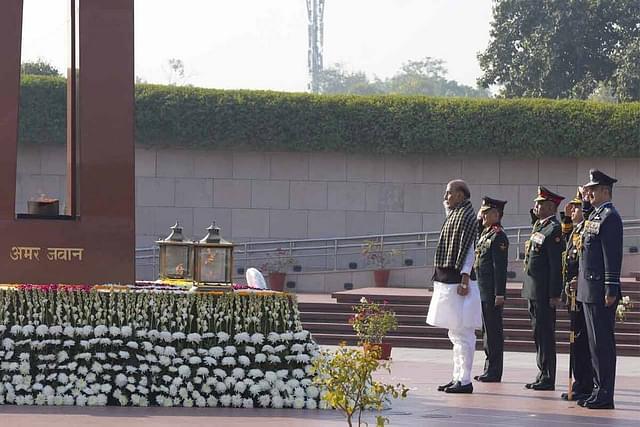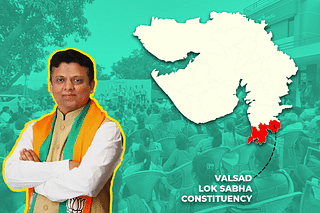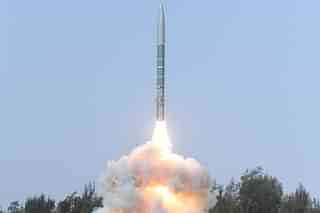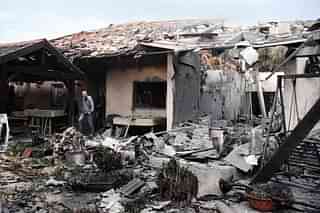Defence
Let Them Buy — Why MoD Should Not Restrict Emergency Procurement
Ujjwal Shrotryia
Feb 05, 2024, 05:32 PM | Updated 06:48 PM IST
Save & read from anywhere!
Bookmark stories for easy access on any device or the Swarajya app.

The Ministry of Defence (MoD) and the Indian armed forces are at odds over the utilisation of the emergency financial powers granted to the vice chiefs of the three services.
The MoD wants the powers be used for revenue procurement (for buying spare parts, etc), while the armed forces advocate for their use in capital procurement (for purchasing new weapons and equipment).
These powers were first granted to the vice chiefs in 2016, following surgical strikes in Pakistan.
The emergency powers allow the vice chiefs to directly purchase weapons worth up to Rs 300 crore from manufacturers, bypassing the MoD's tedious and lengthy Defence Procurement Procedure (DPP) — that takes years to fructify — thus avoiding red tape and rapidly inducting urgently needed equipment for immediate operational use.
Since then, the government has renewed these powers three more times — the most recent in August 2023.
These powers have allowed the three services to plug critical operational gaps, and induct urgently needed equipment and shore up their ammunition reserves, particularly for the northern frontier, where Indian and Chinese forces are in an eyeball-to-eyeball confrontation along the entire Himalayan border.
For instance, the army procured equipment worth Rs 18,000 crore in 140 projects, including rifles, surveillance drones, loitering munitions, counter-drone systems, etc. The air force and the navy purchased bombs, communication systems, and high-mobility vehicles, among others.
However, disagreements between the armed forces and the MoD over restricting these powers to either revenue or capital procurement have sparked concerns.
As the term suggests, emergency powers should be flexible, allowing the procurement of any product 'urgently' required, without being restricted to just spare parts or new weapons.
Consider a hypothetical scenario: if an adversary introduces a hitherto new weapon or tech against the forces, how are they supposed to counter this new weapon, if emergency powers are restricted to purchasing only existing weapons or spare parts?
Limiting these powers will be counterproductive and defeat the whole point of having emergency powers — to help induct operationally critical weapon systems to the frontline, as soon as possible.
Whether the equipment required is an entirely new weapon or just spare parts for 'sustenance', is immaterial.
The government should also stop cribbing, since its utter failure to fix the broken procurement process that led to shortfalls, in the first place, necessitating the need for emergency powers.
The proposal for acquiring six Airbus A-330 MRTT mid-air refuelers for the air force is a prime example of this.
The MoD has denied the procurement of A-330 MRTT mid-air refuelers for the IAF twice, over the last decade and more, citing lack of funds, forcing the IAF to make do with the two-decade-old IL-78 refuelers, that are reportedly suffering from low availability rates.
The armed forces, on the other hand, also bear some of the responsibility, as some shortfalls also stemmed from their own penchant for drafting 'marvel comics' like unrealistic quality requirements (QRs) — sometimes so stringent that even foreign vendors can't match.
The saga of procuring replacement of INSAS rifles is a case in point, where the QRs stipulated changing the caliber of the rifles — from 5.56 mm to 7.62 mm and vice versa, supposedly by simply changing the barrel and magazine of the rifle.
Suffice to say, that project never reached its conclusion, and the forces had to import AK-203 rifles from Russia, the induction of which is also delayed due to protracted cost negotiations and Covid-related shutdown.
Furthermore, the trials and tribulations that the now successful Tejas fighter jet and Arjun tanks had to go through, before their induction in the air force and army, are also noteworthy — marred by delays due to the ever-changing requirements midway in the product development phase, leading to the final product significantly shooting the timeline.
Efforts of both the MoD and the armed forces should be better spent towards addressing the broken procurement process, the very fact that forced the government to grant emergency procurement powers to the services.
Save & read from anywhere!
Bookmark stories for easy access on any device or the Swarajya app.
Editorial Associate at Swarajya. Writes on Indian Military and Defence.
Support Swarajya's 50 Ground Reports Project & Sponsor A Story
Every general election Swarajya does a 50 ground reports project.
Aimed only at serious readers and those who appreciate the nuances of political undercurrents, the project provides a sense of India's electoral landscape. As you know, these reports are produced after considerable investment of travel, time and effort on the ground.
This time too we've kicked off the project in style and have covered over 30 constituencies already. If you're someone who appreciates such work and have enjoyed our coverage please consider sponsoring a ground report for just Rs 2999 to Rs 19,999 - it goes a long way in helping us produce more quality reportage.
You can also back this project by becoming a subscriber for as little as Rs 999 - so do click on this links and choose a plan that suits you and back us.
Click below to contribute.





